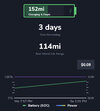Sorry, he's not making weekly trips to the supercharger. I mean the car has a range of over 300 miles. Most people average less than 300/week, and so a weekly trip to the supercharger would suffice with no charging at home at all -- other than, again, the losses of the cold climate.
His level 1 circuit can probably put over 250 miles/week into his car. A properly installed 120v (not 110, that's ancient) circuit can run at 12a continuous.
If you can get 250 miles/week into your car from level 1, your supercharger visits would be rare for your regular driving. (The national average is 230 miles/week driving.) That includes road trips -- and of course you supercharge on road trips. For your weeks when you are not leaving town, you will be below average.
The big unanswered question is what his real charge rate is in the cold. That's easy for him to answer. Do some experiments:
- Plug a cold car in and charge overnight, note miles/hour
- Plug a warm car in and charge overnight, note miles/hour
A model Y gets 4-5 m/h when warm from 120v 12a. Closer to 4 probably. See what you get in the cold. Then figure how many hours you will typically plug in during the week when the electricity is not crazy expensive. That's probably 70 to 100 hours. Work out the math.




